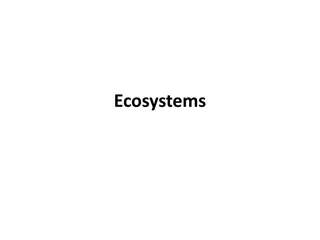Understanding Limiting Factors in Ecosystems: A Case Study of Mono Lake
Explore the concept of limiting factors in populations through a study of Mono Lake's ecosystem. Discover how factors like light and temperature impact algae and brine shrimp populations, and analyze data from experiments conducted to understand population dynamics in controlled environments.
Download Presentation

Please find below an Image/Link to download the presentation.
The content on the website is provided AS IS for your information and personal use only. It may not be sold, licensed, or shared on other websites without obtaining consent from the author. Download presentation by click this link. If you encounter any issues during the download, it is possible that the publisher has removed the file from their server.
E N D
Presentation Transcript
Warm up What is a limiting factor? Give some examples. Any biotic or abiotic factor that acts in some way to limit the number of individuals that survive and reproduce in a population. Temperature Size of habitat, ecosystem Predators .Nom, nom, nom ..!!
Review Mono Lake In Mono Lake we have: Producers: Algae First level consumers: Brine flies and shrimp Second level consumers: birds Third level: Coyotes The field ecologists who study Mono Lake have noted that the populations vary a lot over the course of a year. For example: At times there are almost no brine shrimp and at others there are trillions. They reasoned that there must be some limiting factors at different times of the year.
Review Mono Lake The survival of the whole ecosystem depends on the algae. If the algae population is large, the ecosystem will be able to support a lot of primary consumers. Scientists wanted to understand the factors that limit the populations of two important organisms in the lake, the planktonicalgae and the brine shrimp. We will look at the set up and data from their year long experiment.
Experiments Look at lab pages 34 and 35. They describe the set up and procedures. Eight aquariums were set up and maintained as described on page 34. Each aquarium had only one variable that changed. (In a controlled experiment we can only change ONE variable!) The populations were sampled every month for one whole year. Look at the data that was collected and recorded on page 36. After looking over the experiment and data on pages 34, 35 and 36, answer the questions on page 37. Use complete sentences and give QUALITY conclusions with DATA from the experiment to support them.
Things to think about Which experiments maintained cold temps all year? Which experiments maintained warm temps all year? Which had the same temps as Mono Lake all year? What would a graph of time versus temps look like for the aquariums that had the same temps as Mono Lake through out the year? The water temps would increase in the summer months.
Discuss Analysis Don t forget a limiting factor is any biotic or abiotic factor that acts in some way to limit the number of individuals that survive and reproduce in a population. What effects did you find light and temperature had on Mono Lake and the ecosystem? Within the light and temperature ranges that were studied, algae were not significantly limited. Population increase was slightly slower in the low light situation, but at the end of the year, the algae populations were the same in all four aquariums.
Analysis cont. Brine shrimp were not limited by light intensity, but were significantly limited by temperature. In the low temperature situation, none of the eggs hatched. In the variable-light situation the population growth and decline were directly related to water temp. The greatest population increase was in the warm water.
Other Factors The Mono Lake populations would potentially be subjected to other limiting factors. Algae could be impacted by abiotic factors like carbon dioxide, nutrients and space. Biotic factors could be predation by primary consumers and disease. Brine shrimp could be impacted by abiotic factors like oxygen and space and biotic factors like food, predation by secondary consumers and disease. Limiting Factors and Carrying Capacity. https://www.youtube.com/watch?v=nAElYGMBmpk























